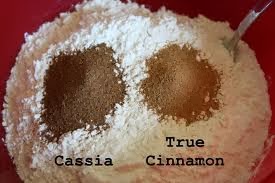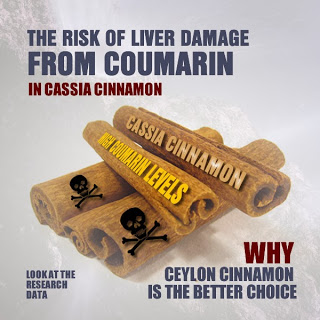Cassia Cinnamon vs Ceylon Cinnamon
I didn’t know there was a difference. Am I alone in that? If so… what IS the difference? IS there even one?
Short answer: YES!
Long answer:
You’re probably buying Cassia cinnamon at the grocery store.
Ceylon cinnamon comes from a different plant: Cinnamomum zeylanicum. An alternative scientific name for Ceylon cinnamon is Cinnamomum verum, which simply translates as “true cinnamon.”
If I haven’t lost you already, you’re asking: okay, different plants, but what’s really the difference?
1. Color: Ceylon is much lighter than Cassia.
 |
| Photo credit: Lulu the Baker |
2. Scent: Ceylon is sweeter and more mellow – a very complex type of flavor. Ceylon isn’t bitter or pungent like Cassia.
Impossible to insert a smell test here, sorry. Stop by my house and I’ll gladly allow you to compare! The difference is pretty incredible, actually.
3. Courmarin content: Courmarin is a naturally occurring toxin which has the potential to damage the liver in high doses. Cassia contains high levels of coumarin,
whereas Ceylon contains either undetectable levels or only traces. Coumarin can cause liver toxicity in several species, and was found to be carcinogenic in rodents Recent studies have revealed that
regularly consuming Cassia cinnamon powder could be problematic,
resulting in potentially harmful levels of coumarin intake. For example,
one study estimated that small children eating oatmeal sprinkled with
cinnamon a few times a week would exceed the established safe upper
limit of exposure. Similarly, they concluded that adults who are heavy
consumers of culinary cinnamon or take powdered cinnamon supplements
could also reach potentially unsafe doses.
Organizations like the Federal Institute for Risk
Assessment in Berlin, Germany have recommended that large amounts of
cassia cinnamon be avoided. Random online fact I thought I’d share 🙂
 |
| Seems like some sort of Fox News headline: Coumarin will kill you! Beware! Ahhh! |
4. Cost: Cassia is cheap. Ceylon is a little more spendy. I tried Flavor of the Earth’s brand, which sells for ~$28/pound. I don’t know that I’d ever go through a pound of cinnamon, but it apparently keeps. I tried to figure out what the price of a pound of Cassia would cost, but couldn’t. I’d guess it’d be somewhere in the $5-10 range?
As you know, I am cheap. I am a couponer/buy only on sale type of person. But, I’m also willing to splurge on things that are actually worthwhile. I actually think this might be one of them???? That’s saying a bit!
5. Taste in Recipes: No comparison! It gives a more complex, sharper taste everything. I also tested it on French Toast with a group, and the entire group gave a big thumbs up. I now try to find reasons to use cinnamon: pies, apple crisps, sprinkled on oatmeal, etc.
 |
| French Toast with Ceylon cinnamon! It was awesome! (I need to improve my photography skills… sorry about that!) |
Apparently, it’s also really good when you add a tsp. to your coffee grounds before brewing. I’m not a coffee person, but might be worth a try? Let me know if it’s terrible :).
6. Does anyone use stick cinnamon? I haven’t (and wouldn’t know how to, actually), but if you do and want to know how to tell the difference, take a look at down the roll: if it’s one piece, it’s likely Cassia. If it looks like there are multiple layers, it’s likely Ceylon (that bark is thinner, so more likely to have multiple layers). Apparently you use a coffee grinder or mortar and pestle to grind the sticks into a powder. Actually sounds intriguing! Wonder if it would take fresher then?
Alright, that’s it for me. I’m actually going to try to make an apple/cinnamon dessert tonight to use up some aging apples. Any suggestions? 🙂
Has anyone else tried Ceylon? Or didn’t know there was a difference (I am not a cook/foodie… so perhaps this is really old news…)?
*Disclaimer: sample provided free from Flavor of the Earth.




